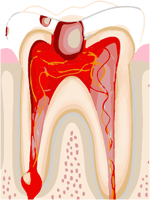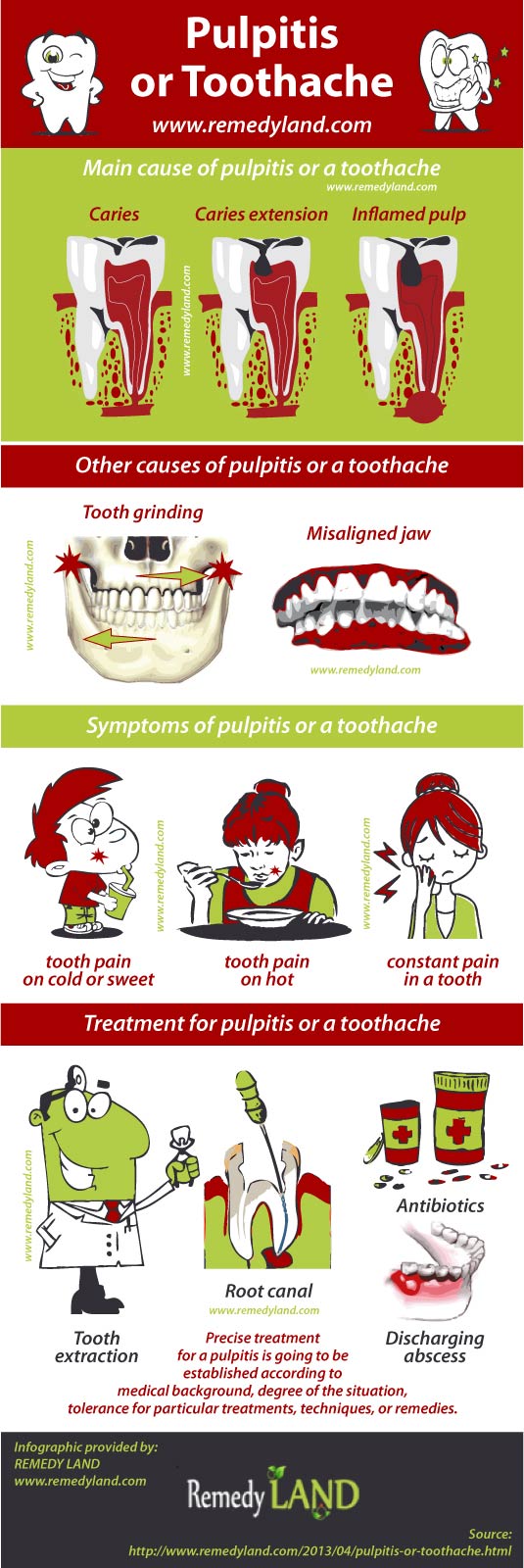What is pulpitis or a toothache?
Pulpitis result from an inflammatory reaction of the pulp inside the tooth. The pulp belongs to the interior of the tooth containing cells and nerves. Just like many bacterial infections, the human body response with raised blood flow and enlarge blood vessels. A toothache typically comes after damage to the tooth.
The best known type of damage to the tooth is from tooth caries or cavity. Oftentimes this is a consequence of inadequate tooth hygiene. Glucose and also starch in meals are the elements that lead to problems for tooth. A tooth with acute pulpitis is very responsive to fluctuation of temperature range.
The discomfort is a consequence of the tension of the pulp because it swells against the inside surfaces of the tooth. In pulpitis acuta serosa, prolonged capillary blood vessels produce the excretion of granulocytes as well as serum
Generally it is a result of dental caries which could enter via the teeth enamel and dentin cellular layers of the tooth to get to the pulp, or perhaps by damage that destroys those layers. Constant damage on the other hand may possibly lead to inflammatory reaction of the pulp without bacterial infection, that may be the consequence of a misaligned jaw, or perhaps teeth grinding during bedtime.
Acute reversible pulpitis
- dental caries
- cavity preparation
- thermal changes in fillings
Acute irreversible pulpitis
- acute caries
- pulp exposure
- sever irritation
Chronic pulpitis
- previous acute pulpitis
- chronic caries
Chronic hyperplastic pulpitis
- opened cavity
- wide apical foramen
Symptoms of pulpitis or a toothache
The signs and symptoms of a toothache can look like some other health problems or dental conditions. A toothache is commonly identified according to an entire background and physical exam. The following are the best known signs and symptoms of a pulpitis.
Signs and symptoms may contain continual pain in a tooth, a tooth is hurtful to contact, discomfort in the tooth that worsens with warm or frosty meals or drinks, tooth typically responds to sugar, the jaw near the area of the tooth is painful and sensitive to contact, fever, and tooth abscesses may appear in cases when pulpitis is progressed. In case the pulpitis is not very advanced the discomfort vanishes from the moment the issue is removed.
In case the pulpitis is progressed and possibly irreversible, the discomfort lingers for quite a while. Chronic pulpitis at the same time is usually entirely without signs and symptoms. It is almost always a result of caries. White blood cells build up in the pulp to fight swelling. In reversible, acute pulpitis, the tooth responds to sweetness, cold and high temperature.
The discomfort can last for a few moments. In irreversible pulpitis, that could be acute or perhaps constant pain, the tooth is irreversibly agonizing. The dentin is usually damaged around the pulpal cavity and cariously modified. Discomfort proceeds despite the fact that caries is eliminate. The affected pulp will never be restored to its genuine natural condition, it really is irreversible, mainly eliminating the irritant from the pulp is not really adequate to prevent the pulpitis. In those occasions it is crucial for the pulp to be taken away by root canal. Strength loss of the tooth marrow will cause pulpal necrosis which at first shows absolutely no signs and symptoms. It might happen via a bacterial inflammation for example gangrene or perhaps after damage without the involvement of harmful bacteria.
Clinical factors associated with pulpal pain
Position of the tooth
Open pulp chamber
Caries
Treatment for pulpitis or a toothache
Therapy for toothache in most cases start by dealing with the reason for the pulpitis which should include the elimination of any kind of irritant. Precise treatment for a pulpitis is going to be established according to medical background, degree of the situation, tolerance for particular treatments, techniques, or remedies and therapy may contain antibiotics, complete or perhaps incomplete tooth extraction, discharging of an abscess, it may be required for the pulp to be taken out by root canal a medical operation that includes the elimination of the affected nerve and cells from the center of the tooth. In the event that the condition is neglected, anaerobic putrefactive microbes degrade the dead cells and even lead to gangrene.
You may also like:
- Home Remedies and Treatments for Sensitive Teeth to Cold and…
All about sensitive teeth: what causes sensitive teeth, teeth sensitive to cold and hot, best toothpaste, treatment and home remedies for sensitive teeth.
- What to eat after Wisdom Teeth removal and Wisdom Teeth…
This is guideline to overcome wisdom teeth removal complications such as: what to eat after wisdom teeth removal, what to do after wisdom teeth removal, wisdom teeth removal recovery time, pain after wisdom teeth removal.
- Dental caries, cavities, tooth decay are the the biggest threat…
Dental caries or cavities, generally referred to as tooth decay, are generated by a meltdown of the tooth enamel. Dental caries is a oral cavity health problem that creates problems for some layers of the tooth.




